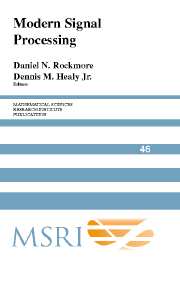Book contents
- Frontmatter
- Contents
- Introduction: A New Generation of Signal Processing
- Hyperbolic Geometry, Nehari's Theorem, Electric Circuits, and Analog Signal Processing
- Engineering Applications of the Motion-Group Fourier Transform
- Fast X-Ray and Beamlet Transforms for Three-Dimensional Data
- Fourier Analysis and Phylogenetic Trees
- Diffuse Tomography as a Source of Challenging Nonlinear Inverse Problems for a General Class of Networks
- An Invitation to Matrix-Valued Spherical Functions: Linearization of Products in the Case of Complex Projective Space P2(ℂ)
- Image Registration for MRI
- Image Compression: The Mathematics of JPEG 2000
- Integrated Sensing and Processing for Statistical Pattern Recognition
- Sampling of Functions and Sections for Compact Groups
- The Cooley-Tukey FFT and Group Theory
- Signal Processing in Optical Fibers
- The Generalized Spike Process, Sparsity, and Statistical Independence
Fast X-Ray and Beamlet Transforms for Three-Dimensional Data
Published online by Cambridge University Press: 25 June 2025
- Frontmatter
- Contents
- Introduction: A New Generation of Signal Processing
- Hyperbolic Geometry, Nehari's Theorem, Electric Circuits, and Analog Signal Processing
- Engineering Applications of the Motion-Group Fourier Transform
- Fast X-Ray and Beamlet Transforms for Three-Dimensional Data
- Fourier Analysis and Phylogenetic Trees
- Diffuse Tomography as a Source of Challenging Nonlinear Inverse Problems for a General Class of Networks
- An Invitation to Matrix-Valued Spherical Functions: Linearization of Products in the Case of Complex Projective Space P2(ℂ)
- Image Registration for MRI
- Image Compression: The Mathematics of JPEG 2000
- Integrated Sensing and Processing for Statistical Pattern Recognition
- Sampling of Functions and Sections for Compact Groups
- The Cooley-Tukey FFT and Group Theory
- Signal Processing in Optical Fibers
- The Generalized Spike Process, Sparsity, and Statistical Independence
Summary
Three-dimensional volumetric data are becoming increasingly available in a wide range of scientific and technical disciplines. With the right tools, we can expect such data to yield valuable insights about many important phenomena in our three-dimensional world.
In this paper, we develop tools for the analysis of 3-D data which may contain structures built from lines, line segments, and filaments. These tools come in two main forms: (a) Monoscale: the X-ray transform, offering the collection of line integrals along a wide range of lines running through the image-at all different orientations and positions; and (b) Multiscale: the (3-D) beamlet transform, offering the collection of line integrals along line segments which, in addition to ranging through a wide collection of locations and positions, also occupy a wide range of scales.
We describe different strategies for computing these transforms and several basic applications, for example in finding faint structures buried in noisy data.
1. Introduction
In field after field, we are currently seeing new initiatives aimed at gathering large high-resolution three-dimensional datasets. While three-dimensional data have always been crucial to understanding the physical world we live in, this transition to ubiquitous 3-D data gathering seems novel. The driving force is undoubtedly the pervasive influence of increasing storage capacity and computer processing power, which affects our ability to create new 3-D measurement instruments, but which also makes it possible to analyze the massive volumes of data that inevitably result when 3-D data are being gathered.
Information
- Type
- Chapter
- Information
- Modern Signal Processing , pp. 79 - 116Publisher: Cambridge University PressPrint publication year: 2004
